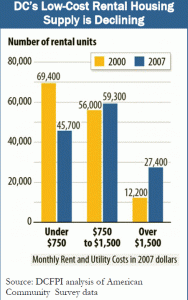The District of Columbia’s housing market boom over the past decade played an important part in the city’s economic revitalization, but it also contributed to a growing affordable housing crisis for low- and moderate-income households. Since 2000, rents have grown faster in the District than in most major cities ‘ and have outpaced the incomes of most DC households. Combined with sharply rising home values and the conversion of many rental units to condominiums, a growing number of DC residents are faced with housing affordability problems. The problems are especially acute for DC’s lowest-income households, most of whom now spend half or more of their income on housing. Although housing prices have moderated over the past year as the housing market cooled, rents and home prices remain far higher than a decade ago.
A review of Census Bureau data on housing conditions in the District reveals the following trends.
- DC’s low-cost rental stock has shrunk by more than one-third since 2000. The number of rental units with rent and utility costs of $750 or less fell from 69,000 in 2000 to 45,000 in 2007. (In this report, all figures are adjusted for inflation to equal 2007 dollars.) Meanwhile the number of rental housing units with costs of at least $1,500 a month more than doubled, from 12,000 in 2000 to 27,000 in 2007.
- Low-cost homeownership options also shriveled: The number of DC homes valued at $250,000 or less fell from 58,000 to 15,000 between 2000 and 2007. Homes valued at this level represented more than half of owner-occupied units in 2000 but just one-sixth in 2007. While home values have fallen in DC since 2007, home prices remain much higher than a decade ago. Median home sales prices at the end of 2008 were roughly double the median sales price from the late 1990s
- A growing number of DC households have housing affordability problems: Nearly 100,000 DC households ‘ or two of five ‘ spent more than 30 percent of income on housing in 2007, exceeding the federal housing affordability standard. The number of DC households with housing affordability problems is 20,000 higher today than in 2000.
Nearly 50,000 DC households ‘ one in five ‘ have severe housing affordability problems, meaning they spend half or more of income on housing. In 2000, some 36,000 DC households faced this situation.
While rising housing costs have affected a wide range of DC families, low-income residents have been hardest hit.
- Nearly all low-income DC households have unaffordable housing costs. Four of five DC households with incomes below 30 percent of the Area Median Income spent more than the federal housing affordability standard. (30 percent of AMI equals about $28,000 for a family four.) Some 62 percent of households with incomes this low spent half or more of their income on housing in 2007 ‘ up from 50 percent who had housing costs this high in 2000.
- Low-income households represent the vast majority of residents in need of affordable housing. While a growing number of moderate-income households also face housing affordability problems, most of the families facing such challenges are low-income. Of the 98,000 households that spend more than 30 percent of income on housing, two-thirds have income below half of the area median income. Of the 48,000 households that spend at least half their income on housing, 85 percent have incomes this low.
Because the private market in the District produces very little housing that is affordable to low-income families, public investment is extremely important to the housing status of DC’s low-income families. Local funding for core affordable housing programs rose substantially starting in 2002 ‘ from $7 million in 2000 to $123 million in 2008. (Both figures are adjusted for inflation to equal 2010 dollars.) This supported the construction or rehabilitation of 6,700 affordable homes ‘ with another 1,600 underway ‘ and the creation of 2,200 rental subsidies for the city’s lowest income residents. It also supported an expansion of first-time homebuyer assistance. The major funding increases occurred in the city’s Housing Production Trust Fund, the Local Rent Supplement Program, and the Home Purchase Assistance Program.
Most of these units were completed before 2007, the year that the housing affordability data in this report were collected. This means that DC’s affordable crisis grew between 2000 and 2007 despite a large local investment in affordable housing, but it also means that the city’s support prevented housing problems from getting even worse.
Funding for all of DC’s major housing programs has been cut in recent years, however, which means that the city is unlikely to have made much progress on the affordable housing problems highlighted in this report. The budget for core housing programs in FY 2010 is $64 million, a nearly 50 percent cut from 2008 and the lowest level since 2004. The Housing Production Trust Fund will receive $18 million in 2010, compared with $62 million in 2008. In addition, the District has not been able to expand the rent subsidy program since 2008, despite a housing waiting list of 25,000 households. Funding for first-time homebuyer assistance has been cut since 2008, forcing the city to reduce the amount of assistance it provides to each household seeking aid.[1]
[1] As discussed in more detail below, this refers to the Home Purchase Assistance Program. It does not refer to the federal first-time homebuyer tax credit.

